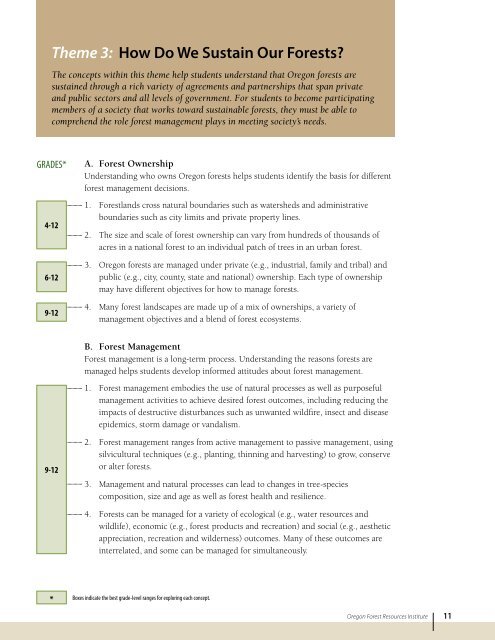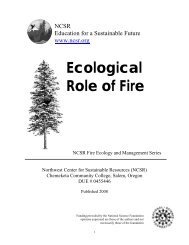Oregon Forest Literacy Program (PDF) - Learn Forests
Oregon Forest Literacy Program (PDF) - Learn Forests
Oregon Forest Literacy Program (PDF) - Learn Forests
Create successful ePaper yourself
Turn your PDF publications into a flip-book with our unique Google optimized e-Paper software.
Theme 3: How Do We Sustain Our <strong>Forest</strong>s?<br />
The concepts within this theme help students understand that <strong>Oregon</strong> forests are<br />
sustained through a rich variety of agreements and partnerships that span private<br />
and public sectors and all levels of government. For students to become participating<br />
members of a society that works toward sustainable forests, they must be able to<br />
comprehend the role forest management plays in meeting society’s needs.<br />
GRADES*<br />
4-12<br />
A. <strong>Forest</strong> Ownership<br />
Understanding who owns <strong>Oregon</strong> forests helps students identify the basis for different<br />
forest management decisions.<br />
1.<br />
2.<br />
<strong>Forest</strong>lands cross natural boundaries such as watersheds and administrative<br />
boundaries such as city limits and private property lines.<br />
The size and scale of forest ownership can vary from hundreds of thousands of<br />
acres in a national forest to an individual patch of trees in an urban forest.<br />
6-12<br />
9-12<br />
3.<br />
4.<br />
<strong>Oregon</strong> forests are managed under private (e.g., industrial, family and tribal) and<br />
public (e.g., city, county, state and national) ownership. Each type of ownership<br />
may have different objectives for how to manage forests.<br />
Many forest landscapes are made up of a mix of ownerships, a variety of<br />
management objectives and a blend of forest ecosystems.<br />
B. <strong>Forest</strong> Management<br />
<strong>Forest</strong> management is a long-term process. Understanding the reasons forests are<br />
managed helps students develop informed attitudes about forest management.<br />
1.<br />
<strong>Forest</strong> management embodies the use of natural processes as well as purposeful<br />
management activities to achieve desired forest outcomes, including reducing the<br />
impacts of destructive disturbances such as unwanted wildfire, insect and disease<br />
epidemics, storm damage or vandalism.<br />
9-12<br />
2.<br />
3.<br />
4.<br />
<strong>Forest</strong> management ranges from active management to passive management, using<br />
silvicultural techniques (e.g., planting, thinning and harvesting) to grow, conserve<br />
or alter forests.<br />
Management and natural processes can lead to changes in tree-species<br />
composition, size and age as well as forest health and resilience.<br />
<strong>Forest</strong>s can be managed for a variety of ecological (e.g., water resources and<br />
wildlife), economic (e.g., forest products and recreation) and social (e.g., aesthetic<br />
appreciation, recreation and wilderness) outcomes. Many of these outcomes are<br />
interrelated, and some can be managed for simultaneously.<br />
* Boxes indicate the best grade-level ranges for exploring each concept.<br />
<strong>Oregon</strong> <strong>Forest</strong> Resources Institute<br />
11



